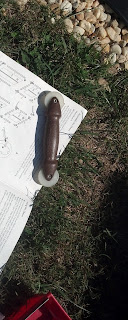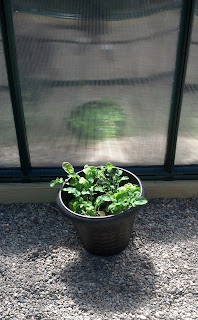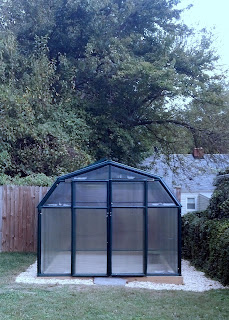It's done - it's built - it has at least one plant in it! It took five weekends, but it's built! We are so excited.
 The last step was putting on the doors. There are four - two in the front and two in the back.
The last step was putting on the doors. There are four - two in the front and two in the back.There was also more weather stripping to do. I can't recommend enough that you find one of these weather-stripping rollers at your local hardware store - it made installing and adjusting our weather stripping a LOT easier.

 After five weekends of work, sweat, a little blood, and a lot of parts, we were finally done. We closed the doors and found an almost instantaneous increase in temperature - it's almost too hot in there for plants now, but this will be a good thing in a few weeks when it starts to get chilly out.
After five weekends of work, sweat, a little blood, and a lot of parts, we were finally done. We closed the doors and found an almost instantaneous increase in temperature - it's almost too hot in there for plants now, but this will be a good thing in a few weeks when it starts to get chilly out.Then it was time to put our first plant in the greenhouse. I have some arugula that's been waiting to go in there - of course we have plenty of room. Now that we've christened the greenhouse with the first plant, we're ready to create the raised beds.
We're planning to build two beds along the lefthand side of the structure - each about 5 feet by three feet, with a little pathway in between so we can reach the whole planting areas without stepping on our delicate plants.

We want to use composite lumber - most of the pressure-treated stuff is infused with arsenic and we don't want than in our beets and tomatoes.
If we use non-pressure treated wood, then it will rot in a couple of years and we'll have to tear down the beds and rebuild them.
So, the best choice is to spend more money up front for beds that will hold up well for years, and that won't leach arsenic into our garden.
At this point, we're looking into suppliers and pricing it out; in the mean time, we'll be gathering other furniture, plants, etc. to place in our space.
Finally, here's a bonus shot of Tito, who was supervising our work from the cool shade of the shed.
 |
So, what's your garden up to these days? Please share in the comments.
Next time: Seedling update, moving plants from our house to the greenhouse.
























